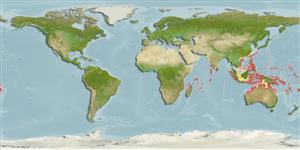Actinopterygii (ray-finned fishes) >
Perciformes (Perch-likes) >
Lethrinidae (Emperors or scavengers) > Lethrininae
Etymology: Lethrinus: Greek, lethrinia, a fish pertaining to genus Pagellus. More on author: Valenciennes.
Environment / Climate / Range
Ecology
Marine; reef-associated; non-migratory; depth range 4 - 35 m (Ref. 90102). Tropical, preferred ?; 30°N - 21°S
Indo-West Pacific: Sri Lanka to the Marshall and Solomon islands, north to the Ryukyu Islands, south to northern Australia.
Size / Weight / Age
Maturity: Lm ? range ? - ? cm
Max length : 35.0 cm TL male/unsexed; (Ref. 2295); common length : 29.0 cm SL male/unsexed; (Ref. 37816)
Dorsal
spines
(total): 10;
Dorsal
soft rays
(total): 9;
Anal
spines: 3;
Anal
soft rays: 8. Body is brown or tan, with scattered irregular small black blotches, a large oblong black blotch below soft-rayed portion of dorsal fin and bordering below the lateral line. The fins are pale or pinkish.
Solitary or in groups (Ref. 90102). Inhabits shallow seagrass beds, reef flats, lagoons, and sandy areas near coral reefs. Feeds on benthic invertebrates and small fish. Also caught with beach seines and handlines and is marketed fresh (Ref. 9775).
Life cycle and mating behavior
Maturity | Reproduction | Spawning | Eggs | Fecundity | Larvae
Carpenter, K.E. and G.R. Allen, 1989. FAO Species Catalogue. Vol. 9. Emperor fishes and large-eye breams of the world (family Lethrinidae). An annotated and illustrated catalogue of lethrinid species known to date. FAO Fish. Synop. 125(9):118 p. Rome: FAO. (Ref. 2295)
IUCN Red List Status (Ref. 115185)
CITES (Ref. 94142)
Not Evaluated
Threat to humans
Harmless
Human uses
Fisheries: minor commercial
More information
Common namesSynonymsMetabolismPredatorsEcotoxicologyReproductionMaturitySpawningFecundityEggsEgg development
ReferencesAquacultureAquaculture profileStrainsGeneticsAllele frequenciesHeritabilityDiseasesProcessingMass conversion
Tools
Special reports
Download XML
Internet sources
